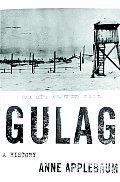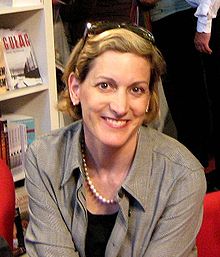 Ann Applebaum has to be the reigning expert on Soviet atrocities. It seems a strange way to spend one’s professional life, but it’s rewarded her with a Pulitzer for Gulag and a deserved reputation for fine writing and terrific research in a just-opening field. The records are scattered, and just coming to light, and any author who chooses to tackle them must be possessed of skills, languages, and a willingness to cover miles and years to delve into them. There must be few so qualified, and we’re lucky that someone with the writing prowess of Applebaum is one of them.
Ann Applebaum has to be the reigning expert on Soviet atrocities. It seems a strange way to spend one’s professional life, but it’s rewarded her with a Pulitzer for Gulag and a deserved reputation for fine writing and terrific research in a just-opening field. The records are scattered, and just coming to light, and any author who chooses to tackle them must be possessed of skills, languages, and a willingness to cover miles and years to delve into them. There must be few so qualified, and we’re lucky that someone with the writing prowess of Applebaum is one of them.
The Gulag, you might think, had been more than adequately described by Solzeneitsehn. And in a sense, you’d be right. We could hear the music fine in his Archipelago, but Applebaum gives us the process of the composition and access to the score and libretto.
She begins with Lenin, the 1917 revolution, and the problem of what to do with the conquered. Not so much the Czarist conquered, but the viks who weren’t Bolsheviks and still wanted a piece of the revolutionary action. Vladimir’s answer was concentration camps.They weren’t a new idea for Russia. They dated at least back to the 18th century and Peter the Great’s notion of relocating whole towns for specific purposes—like constructing St. Petersburg on top of a swamp. So the policy of sending enemies off to the frozen wastes to help populate distant provinces to provide the motherland with wood and minerals and furs came rather naturally. There were other motives, of course. In the beginning, there was some hope that these places could be educational enterprises where talented artists and intellectuals would be persuaded to give up their bourgeois  individualism, value the dictatorship of the proletariat, and eventually be reintegrated into society at large. In fact, many of the original inmates found life in some of the camps rather pleasant and productive. They were kept comfortable and allowed to write and form artistic groups.
individualism, value the dictatorship of the proletariat, and eventually be reintegrated into society at large. In fact, many of the original inmates found life in some of the camps rather pleasant and productive. They were kept comfortable and allowed to write and form artistic groups.
Gradually, though, reality and philosophy changed. People were not being converted to the cause in anything like sufficient numbers. The camps were expensive. There emerged the notion that they should be self-sustaining. Thus, the imposition of work quotas for, say, woodcutting or coal tonnage, even in Siberian midwinter. The doctrine of those who do not work do not eat—even thoue who didn’t work because of injury or illness—say, frostbite from a 12 hour stint swinging an ax in knee-deep snow, or malnutrition from a diet of watery gruel that Oliver Twist would turn down.
Also at first, political prisoners were kept separate from criminals. That turned out to be too much trouble, so everyone was thrown in together. What Lenin started, Stalin doubled down on. His innate paranoia and cruelty made even Hitler look kind by comparison. At least Mr. H concentrated on a specific ethnic group for a specific purpose. Stalin threw whoever in just because. It helped keep folks in line. And the system grew and expanded enemy by enemy, camp by camp, fitting almost artfully into the stunningly brutal mosaic of Stalinist history.
Gulag’s a disturbing and insightful look into the depths of man’s inhumanity. As if we needed more reminders of that these days.